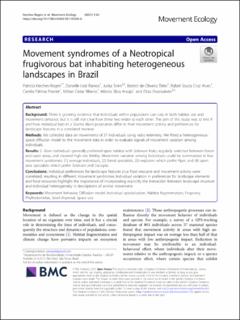| dc.contributor.author | Kerches-Rogeri, Patricia | |
| dc.contributor.author | Ramos, Danielle Leal | |
| dc.contributor.author | Siren, Jukka | |
| dc.contributor.author | de Oliveira Teles, Beatriz | |
| dc.contributor.author | Alves, Rafael Souza Cruz | |
| dc.contributor.author | Priante, Camila Fátima | |
| dc.contributor.author | Ribeiro, Milton Cezar | |
| dc.contributor.author | Araújo, Márcio Silva | |
| dc.contributor.author | Ovaskainen, Otso | |
| dc.date.accessioned | 2023-01-16T12:14:50Z | |
| dc.date.available | 2023-01-16T12:14:50Z | |
| dc.date.created | 2021-12-14T13:48:24Z | |
| dc.date.issued | 2021 | |
| dc.identifier.citation | Movement Ecology. 2021, 9 (35), . | en_US |
| dc.identifier.issn | 2051-3933 | |
| dc.identifier.uri | https://hdl.handle.net/11250/3043706 | |
| dc.description.abstract | Background
There is growing evidence that individuals within populations can vary in both habitat use and movement behavior, but it is still not clear how these two relate to each other. The aim of this study was to test if and how individual bats in a Stunira lilium population differ in their movement activity and preferences for landscape features in a correlated manner.
Methods
We collected data on movements of 27 individuals using radio telemetry. We fitted a heterogeneous-space diffusion model to the movement data in order to evaluate signals of movement variation among individuals.
Results
S. lilium individuals generally preferred open habitat with Solanum fruits, regularly switched between forest and open areas, and showed high site fidelity. Movement variation among individuals could be summarized in four movement syndromes: (1) average individuals, (2) forest specialists, (3) explorers which prefer Piper, and (4) open area specialists which prefer Solanum and Cecropia.
Conclusions
Individual preferences for landscape features plus food resource and movement activity were correlated, resulting in different movement syndromes. Individual variation in preferences for landscape elements and food resources highlight the importance of incorporating explicitly the interaction between landscape structure and individual heterogeneity in descriptions of animal movement. | en_US |
| dc.language.iso | eng | en_US |
| dc.publisher | BMC | en_US |
| dc.rights | Navngivelse 4.0 Internasjonal | * |
| dc.rights.uri | http://creativecommons.org/licenses/by/4.0/deed.no | * |
| dc.title | Movement syndromes of a Neotropical frugivorous bat inhabiting heterogeneous landscapes in Brazil | en_US |
| dc.title.alternative | Movement syndromes of a Neotropical frugivorous bat inhabiting heterogeneous landscapes in Brazil | en_US |
| dc.type | Peer reviewed | en_US |
| dc.type | Journal article | en_US |
| dc.description.version | publishedVersion | en_US |
| dc.source.pagenumber | 0 | en_US |
| dc.source.volume | 9 | en_US |
| dc.source.journal | Movement Ecology | en_US |
| dc.source.issue | 35 | en_US |
| dc.identifier.doi | 10.1186/s40462-021-00266-6 | |
| dc.identifier.cristin | 1968382 | |
| cristin.ispublished | true | |
| cristin.fulltext | original | |
| cristin.qualitycode | 1 | |

